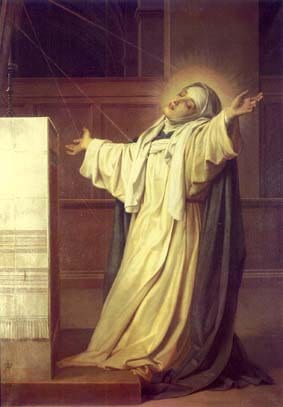This episode is titled The Mystics and looks at the Mysticism of the Western Church during the Late Middle Ages.
Alongside the Scholastics we spent a couple episodes on, was another movement within Medieval Christianity in Europe led by a group known as “The Mystics.”
Don’t let that title mislead you. They weren’t wizards with black, long-sleeved robes and tall pointed hats embellished with moons and stars. Don’t picture Gandalf or some old man bent over a dusty tome reciting an incantation. The Mystics weren’t magicians. They were Christians who thought a vital part of the Faith had been left behind by the academic pursuits of the Scholastics. They aimed to reclaim it.
Think of the Medieval Christian mystics this way; if the Scholastics sought to synthesize faith and reason, to give a rational base for the Christian faith, the Mystics wanted such reason to be fervent. If Scholastics emphasized the head, Mystics emphasized the heart. They wanted there to be some heat added to the light the Scholastics shined on the Faith. They added adoration to analysis.
The primary message of the Mystics was the call for Christians to maintain a deeply personal and intimate connection to God. For some, that still meant going through the sacraments we looked at in the last episode, but the goal was to experience the divine. This is why they were called Mystics; their movement = Mysticism. That experience of the divine was inexpressible—indescribable. No formula can be given to obtain it, and once felt, to adequately describe it. It’s a mystery, one the mystics thought believers ought to aim for; the essence of the soul’s communion with God.
The word which best captures the activity of the mystics is devotion. While the Scholastics looked for evidence of God “out there” the Mystics looked within. Not for some internal divine essence, as the earlier Gnostics had or some later mystics would. Rather, they engaged in an inner quest to discover the presence of the Holy Spirit working to conform them to the image of Christ. Faith wasn’t merely an intellectual pursuit. Mystics wanted to FEEL their faith, or better, what their faith was fixed on. They relied more on experience than definitions.
There’s a common misconception about the medieval mystics that they were all hermits; living in seclusion in some esoteric pursuit of the divine. That’s not the case. For the most part, they weren’t recluses. They lived in monastic communities.
The Mystics drew a good part of their material from the 5th C Church Father Augustine, who also furnished the Scholastics with their core ideas. It was Augustine who said, “You have made us for Yourself O God and our hearts are restless until they find their rest in Thee.”
While Mysticism and Scholasticism are often set over against each other as separate movements, the truth is, most of the Scholastics show a flavor of the mystical, just as the Mystics often show a surprising element of the rational. The mystical element was strong in the greatest of the Scholastics; Anselm, Thomas Aquinas, and Bonaventure.
While Scholastic theology was developed in the cathedral schools and new universities, Mysticism grew up in convents and monasteries. Clair Vaux and St. Victor near Paris were the nurseries of medieval Mysticism. It was in the cloistered halls of monasteries that the passionate hymns of the Middle Ages were composed.
The leading Mystics of this period were Bernard of Clair Vaux, Hugo and Richard of St. Victor, Joachim of Fiore. Hildegard and Elizabeth of Schoenau [Sker-naw] belong in a class by themselves.
Bernard is considered one of the first medieval mystics, though he lived well before the flowering of Mysticism in the 13th C. His writings reveal an intimate acquaintance with Scripture. One historian called him the religious genius of the 12th C, the leader of his age, the greatest preacher Germany ever had. In matters of spiritual contemplation he was a new Augustine.
Bernard maintained it was prayer and devotion that led to the knowledge of God rather than doctrinal disputes. It’s the saint rather than the scholar who understands God. Humility and love are the fundamental ethical priorities of theology. In other words, Bernard said, if our learning about God does not bring us nearer His moral makeup, it’s a false knowledge.
Bernard reformed the community life of convents and monasteries. But he said the cloistered life, with its vigils and fastings, isn’t an end in itself; it’s but a means to develop the two fundamental Christian virtues of humility and love.
Sounding very much like one of our finest Bible teachers today, Bernard said our love grows alongside our apprehension of God’s love. He maintained as the soul contemplates the cross it’s pierced with the sword of love, as when the Song of Solomon says, “I am sick from love.” Love towards God has its reward, but love loves without regard for reward.
Then, moving more into what we might call classic mystical expression Bernard wrote – As the drop of water dropped into wine loses its color and taste, or as iron held in the fire loses its shape and becomes like the flame, or as air illuminated by the light of the sun, becomes itself like the light, even so all feeling in the believer is wholly infused and transmuted by God’s will, so that God becomes all and in all.
Bernard preached 86 Sermons on the Song of Solomon. Not 8, not 6 – 86! And he only made it to the 1st verse of the 3rd chapter. Every one of them was a mediation on love, both God’s prior love and man’s reply. While commentaries on the Song of Solomon are rare today, it was a favorite of the Middle Ages precisely because of the influence of the Mystics who used it as the premier text for meditations on God. Everything in it is allegorized.
The mysticism of Bernard centers in Christ. It is by contemplation of Him that the soul is filled with knowledge and ecstasy. The goal which the soul aspires to is that Christ may live in us, and our love to God becomes the all-controlling affection.
The Abbey of St. Victor in Paris became a center of mystical theology in the 12th C. The two most famous Mystical leaders who worked there were Hugo and his pupil, Richard. With both men, Mysticism was linked to the work of the Scholastics. With Bernard, mysticism was a highly developed personal experience. With the Victorines, it was brought within the limits of careful definition and became a system. Hugo and Richard centered their activity on the convent, taking no part in the public controversies of the age, where as we’ve seen in other episodes, Bernard was all over the place in the early 12th C; preaching up the 2nd Crusade, participating in the Great Papal Schism, founding the Knights Templar, and a host of other major events.
Hugo, the first of the great German theologians, was born about 1097 in Saxony. In 1115 he went to Paris and became a monk at St. Victor’s. He was a friend of Bernard’s. Hugo left behind him many writings. He was an independent and fair thinker who influenced contemporary writers by whom he’s often quoted. He wrote commentaries on Romans, Ecclesiastes, and other books of the Bible, and a treatise on what would now be called a Biblical Introduction. Going against the standard allegorical slant most Bible study of the time followed, Hugo emphasized the historical sense of the text. But having developed that historical sense, Hugo went on to allegorize the text along mystical lines.
Richard of St. Victor was Hugo’s student. If Hugo was reserved, Richard was extravagant. We know little of his life other than he was born in Scotland and became prior of St. Victor in the late 12th C.
Richard’s style was awash in exuberance. His commentaries on the Books of the Bible follow a truly mystical path as he sees all kinds of connections between the Gospel and the stories of the Old Testament. Today we’d call Richard an inveterate Possibility-thinker. In his work titled Emmanuel, a treatise directed to Jews, he praised sin as a happy misdemeanor,—felix culpa,—because it brought about the Incarnation of Christ. è I guess that’s one way to look at it.
For all Richard’s mystical leanings, he magnifies Scripture and makes it the test of spiritual experiences. This is something modern mystics should take to heart. Everything, Richard said, is to be looked upon with suspicion which does not conform to the letter of Scripture.
The leading idea of these two Victorines is that we must believe, love, and sanctify ourselves in order that the soul may reach the ecstasy and composure of contemplation in the knowledge of God. The Scriptures are the supreme guide and the soul by contemplation reaches a spiritual state which the intellect and argumentation could never bring it to.
Hildegard was born to noble parents in Germany. From the age of three she experienced visions, which over time revealed to her the nature of God and the universe. At a young age, her parents sent her to be educated at a Benedictine convent where she spent the rest of her life.
In 1141, for the first time, she informed others of her visions. They persuaded her to have the revelations she had experienced written down. It was titled Scivias and became a classic of medieval mysticism. The highest authorities in the church, including the Pope, regarded her as a prophetess.
Bernard of Clair Vaux was numbered as one of her admirers. They carried on a lifelong correspondence dealing, among other topics, with the need for church reform. Because of her leadership abilities, she eventually became abbess of her convent and in 1148 founded a new convent near Bingen where she remained until her death. Besides her administrative duties, she maintained a wide correspondence and authored books on science, medicine, hymnology, and lives of the saints. She joined other leaders of the church in condemning the heresy of the Cathars but unlike others she opposed sentencing them to death.
Caterina Benincasa’s birth into a middle-class wool dyer’s family caused scarcely a ripple; she was after all, the 23rd of 25 children. Another event that year, a flea full of the bacillus pestis entered the Italian port of Messina and brought a tidal wave of disease called the “Black Death.” In just 3 years, 1348 to 50, more than a third of Europe died. Baby Catherine somehow survived the Plague.
As a young girl, she often went to a cave near her home in Siena to meditate, fast, and pray. At 7, she claimed to have seen a vision of Jesus and announced to her parents her determination to live a religious life. Convinced of her devotion, they gave her a small room in the basement of their home that acted as a hermitage. She slept on a board with a log for a pillow. A few years later at the age of 15 her parents thought her period of religious devotion had run its course and that she ought to marry. She cut off her hair to thwart their designs.
The path for young women at that time who wanted to devote themselves to the religious life was to enter a convent as a nun. But Catherine didn’t want a contemplative life; she wanted to help the poor and sick. Her cousin was a Dominican priest who persuaded her to join the Dominicans as a lay sister. She lived at home, wore distinctive clothes, and directed her activities in sacrificial service to the needy.
From 16 to 19, Catherine continued living a secluded life at home and attracted many followers, who were drawn by her feisty personality and exemplary sanctity. She learned to read and became familiar with the Church Fathers; Gregory the Great and Augustine, as well as the popular preachers of the day. At the end of this 3-year seclusion, Catherine experienced what she later described as a “spiritual marriage” to Christ. In a vision, Jesus placed a ring on her finger, and her soul attained mystical union with God.
She returned to her ministry to the poor, sick, and imprisoned of Siena. When a wave of the plague struck her hometown in 1374, most people fled, but she and her followers stayed to nurse the ill and bury the dead. She was tireless, working day and night, healing all of whom the physicians despaired.
When the crisis ended, she began a letter-writing ministry to convert sinners and reform the Church and society. Like many reformers of the day, she was disturbed by the blatant corruption of Church officials, and believed the source of the problem was the Great Papal Schism. In a series of letters, Catherine exhorted the Pope to address the problems of the church and charged him to return to Rome. She wrote, “Respond to the Holy Spirit who is calling you! I tell you: Come! Come! Come! Don’t wait for time because time isn’t waiting for you.”
A year later, in 1377, after Catherine visited with him in Avignon, Gregory XI finally returned to Rome. It was the great moment of her public life.
In her 383 letters and book The Dialogue, Catherine describes her mystical experiences and her all-consuming desire to love God.
At the heart of Catherine’s teaching was the image of a bleeding Christ, the Redeemer—ablaze with fiery charity, eager sacrifice, and unqualified forgiveness. It wasn’t the cross or nails that held Christ to the tree; those were not strong enough to hold the God-Man. It was love that held Him there.
Catherine died in Rome at the age of just 33. What a life she lived and example she set.






I just want to congradulate you for all that you do. Your committment to education is commendable. Your podcasts are wonderful. Thank you so much for all you do.
Thanks Ryan